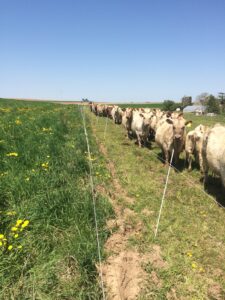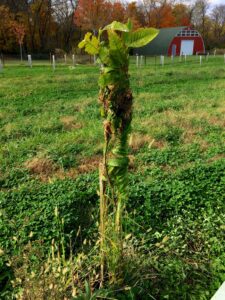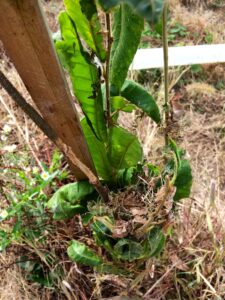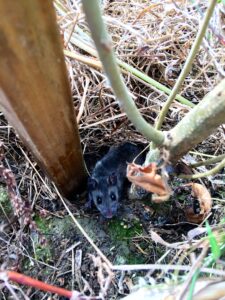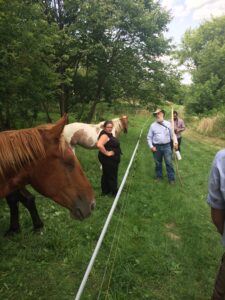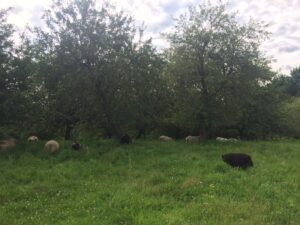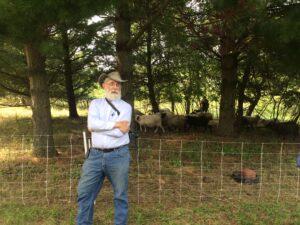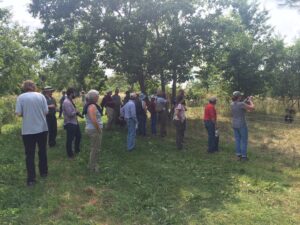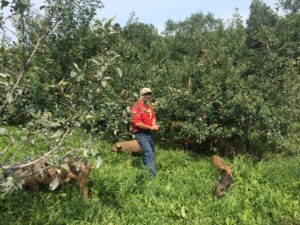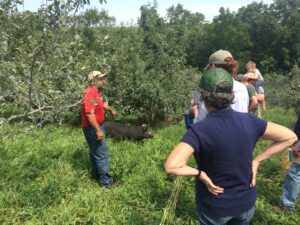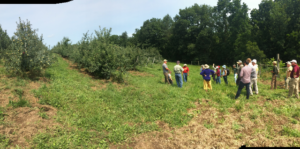Project Overview
Annual Reports
Information Products
Commodities
- Agronomic: grass (misc. perennial), hay
- Fruits: apples, apricots, berries (brambles), berries (other), cherries, peaches, pears, plums
- Nuts: chestnuts, hazelnuts, pecans
- Additional Plants: native plants, trees
- Animals: bovine, poultry, sheep, swine
Practices
- Animal Production: feed/forage, grazing management, grazing - multispecies, grazing - rotational, housing
- Crop Production: windbreaks
- Education and Training: demonstration, farmer to farmer, mentoring, networking, on-farm/ranch research, participatory research
- Farm Business Management: agricultural finance, budgets/cost and returns, new enterprise development
- Natural Resources/Environment: afforestation, biodiversity, hedges - woody
- Pest Management: competition, cultural control, field monitoring/scouting, prevention
- Production Systems: integrated crop and livestock systems, organic agriculture, permaculture
Abstract:
Silvopasture – the integration of livestock, forage, and trees – can generate multiple high-value products with minimal off-farm inputs while enhancing ecological functions. Silvopasture remains largely untested in the Midwest US. To fill knowledge gaps faced by farmers in this region, we tested techniques of integrating livestock with seedling trees in pastures. Our trials on four farms in Wisconsin, Illinois, and Indiana including various types of livestock compared efficacy of different techniques for mitigating livestock and wildlife damage to trees, as well as potential competition from nearby herbaceous vegetation. We also conducted semi-structured exit interviews with participating farmers to document their qualitative assessment of strategies to establish and manage trees planted in pastures.
Effective methods for protecting seedling trees in silvopasture varied based livestock species as well as some environmental factors. Little to no protection was needed for pastured poultry, especially chickens. Wire cages most effectively prevented damage from larger livestock, but this method also was the most expensive and may be cost-prohibitive when trying to protect many trees. For large-scale silvopasture establishment, a combination of electric fencing with tree tubes works well for protecting the trees from damage while allowing livestock grazing to help manage competing vegetation. Tubes, alone, can be effective at protecting tree seedlings from sheep, provided that stakes are sufficiently sturdy.
Farmer-researchers reported general satisfaction with their silvopasture establishment. They have maintained their trial areas and in all cases either adopted more effective techniques learned in the course of the project and/or expanded silvopasture acreage. Outreach efforts made information gained through the research available in a several ways: field days at participating farms; conference presentations and webinars by farmers and ag professional; public release of recorded interviews between beginning silvopasturists and experienced practitioners; and improving network connectivity and availability of educational resources on the web. A manuscript of the research is also in preparation for a peer-reviewed scientific journal in order to share our findings with academic audiences.
[caption id="attachment_374313" align="alignnone" width="300"] Micheal Dolan works on installing Arbor Shield wire cages at Driftless Pastures, WI.[/caption] [caption id="attachment_374312" align="alignnone" width="224"]
Micheal Dolan works on installing Arbor Shield wire cages at Driftless Pastures, WI.[/caption] [caption id="attachment_374312" align="alignnone" width="224"] Hogs in silvopasture at Nightfall Farm, IN.[/caption] [caption id="attachment_374311" align="alignnone" width="225"]
Hogs in silvopasture at Nightfall Farm, IN.[/caption] [caption id="attachment_374311" align="alignnone" width="225"]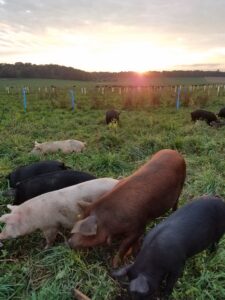 Hogs and silvopasture at Green Fire Farm, WI.[/caption] [caption id="attachment_374320" align="alignnone" width="300"]
Hogs and silvopasture at Green Fire Farm, WI.[/caption] [caption id="attachment_374320" align="alignnone" width="300"]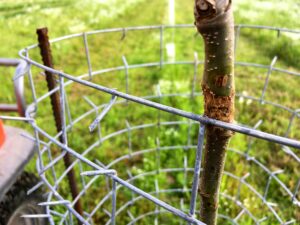 Wire cage bark rub at Seven Sisters Farm, IL.[/caption] [caption id="attachment_374319" align="alignnone" width="225"]
Wire cage bark rub at Seven Sisters Farm, IL.[/caption] [caption id="attachment_374319" align="alignnone" width="225"]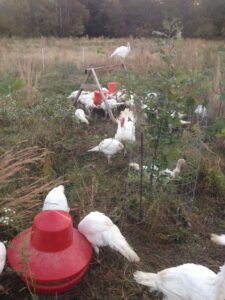 Turkeys in silvopasture at Nightfall Farm, IN.[/caption] [caption id="attachment_374318" align="alignnone" width="300"]
Turkeys in silvopasture at Nightfall Farm, IN.[/caption] [caption id="attachment_374318" align="alignnone" width="300"]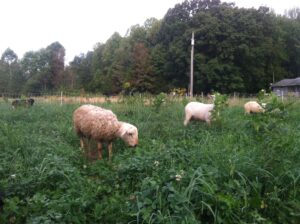 Sheep grazing in silvopasture at Nightfall Farm, IN.[/caption] [caption id="attachment_374317" align="alignnone" width="300"]
Sheep grazing in silvopasture at Nightfall Farm, IN.[/caption] [caption id="attachment_374317" align="alignnone" width="300"]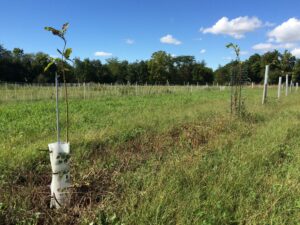 2' Bark Pro Tubes (foreground), Wire Cages, 5' Miracle Tree Pro Tubes, 4' Miracle Tree Pro Tubes in the same row at Seven Sisters Farm, IL.[/caption] [caption id="attachment_374316" align="alignnone" width="300"]
2' Bark Pro Tubes (foreground), Wire Cages, 5' Miracle Tree Pro Tubes, 4' Miracle Tree Pro Tubes in the same row at Seven Sisters Farm, IL.[/caption] [caption id="attachment_374316" align="alignnone" width="300"]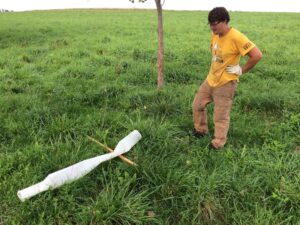 Micheal Dolan inspecting cattle damage to tree tube protectors at Driftless Pastures, WI.[/caption] [caption id="attachment_374315" align="alignnone" width="225"]
Micheal Dolan inspecting cattle damage to tree tube protectors at Driftless Pastures, WI.[/caption] [caption id="attachment_374315" align="alignnone" width="225"]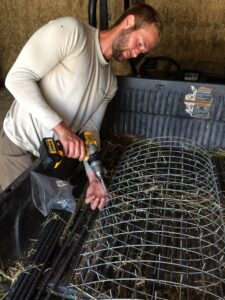 Jacob Marty working on installing Arbor Shield wire cages at Green Fire Farm, WI.[/caption] [caption id="attachment_507251" align="alignnone" width="300"]
Jacob Marty working on installing Arbor Shield wire cages at Green Fire Farm, WI.[/caption] [caption id="attachment_507251" align="alignnone" width="300"]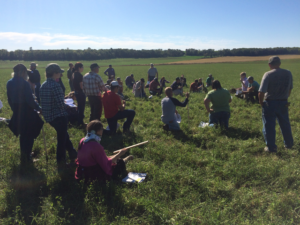 Green Fire Farm field day, 2017.[/caption] [caption id="attachment_507262" align="alignnone" width="300"]
Green Fire Farm field day, 2017.[/caption] [caption id="attachment_507262" align="alignnone" width="300"]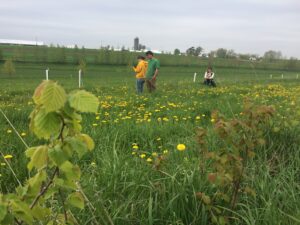 Tree survival census at Driftless Pastures, WI.[/caption] [caption id="attachment_507252" align="alignnone" width="300"]
Tree survival census at Driftless Pastures, WI.[/caption] [caption id="attachment_507252" align="alignnone" width="300"]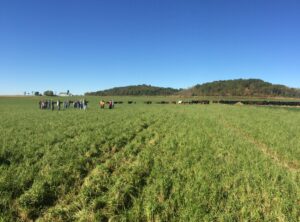 Field day at Green Fire Farm; 104 attendees.[/caption]
Field day at Green Fire Farm; 104 attendees.[/caption]
Single-strand electric fencing protects newly planted tree seedlings at Driftless Pastures, WI.
Rodent nesting in tree tubes was sometimes a problem at Seven Sisters Farm, IL.
Silvopasture for horses and sheep with nut, apple, and pine canopy trees at Badgersett Research Farm, MN.
Hog silvopasture with apple trees at Hoch Orchard, MN.
Project objectives:
- Perform replicated trials of fencing and tree protection strategies in seedling-stage silvopastures on four farms, each integrating different species of livestock
- Track costs and required labor of establishing and managing seedling-stage silvopastures
- Record interviews and publish podcasts of conversations between beginning graziers and experienced silvopastoralists about best practices in establishing and managing silvopastures.
- Develop an online silvopasture hub for knowledge exchange within a map-based network of perennial agriculture practitioners, researchers, and educators
- Share research results via silvopasture hub, field days, conference presentation, and a bulletin
- Provide on-farm demonstration of effective silvopasture establishment techniques to field day attendees.
